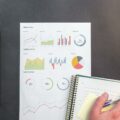Wall Street Records Third Quarterly Loss As Recession Looms

On Friday, the S&P 500 closed the books on the sharpest decline it has recorded in September in about two decades.
It skidded across the finish line of the year’s third quarter that has proven to be quite tumultuous, as it brought rising interest rates, historically high inflation and recession worries.
Markets decline
Early in the session, the three major indexes on Wall Street had enjoyed a brief rally, but it was soon quashed and brought them down to end the session sharply lower.
The Dow Jones Industrial Average and the S&P 500 index recorded their third straight weekly decline and all three of the indexes also recorded monthly losses for the second consecutive month.
There were three quarterly consecutive declines for Wall Street in the first nine months of this year, which is the longest losing streak that the Nasdaq and the S&P 500 have seen since 2008.
It is also the longest quarterly slump that the Dow has recorded in seven years. Market analysts said that this brought an ugly end to an equally ugly quarter, which is part of an ugly year.
They said that when investors look back upon 2022, they will remember it as the year when the Fed did a complete 180 on their perspective of inflation and became extremely hawkish.
The Fed
The markets have been rattled by the Federal Reserve because it has been on an aggressive path of hiking interest rates that have not been seen in decades in order to bring down the equally hot inflation.
A number of market participants are now looking at key economic data to see if there are any signs of an economic recession.
Market analysts said that participants have realized that the Fed is willing to do anything to bring down the inflation that has touched 4-decade highs.
Therefore, they are now worried that this aggressiveness can drive the economy over the brink and straight into a recession.
The personal consumption expenditure (PCE) report of the Commerce Department did not do much to assuage those concerns.
This is because it showed that while consumers are still spending, there has been a rise in prices they are paying, which means that inflation is moving way beyond the Fed’s target.
It indicates that the Fed is highly unlikely to move away from its hawkish stance anytime soon.
Indexes fall
There was a 1.71% drop in the Dow Jones Industrial Average, which brought it down by 500.1 points to end at 28,725.51.
The S&P 500 suffered losses of 1.51% for the day, which saw it come down by 54.85 points to reach 3,585.62.
Meanwhile, there was also a 1.51% loss in the Nasdaq Composite and this took it down by 161.89 points to end at 10,575.62.
Out of the 11 sectors of the S&P 500 index, there was only one that gained and that was real estate, while the largest percentage declines were seen in utilities and tech.
Apple Inc., Nike, Amazon.com and Microsoft Corp were weighing the most.




















